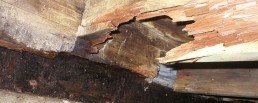Wood Rot Identification and Treatment
Damp…wood rot…they seem inevitable in a climate like ours, don’t they?
It doesn’t have to be that way: simple measures help keep both at bay. Yet if they lie undiscovered, or ignored, they can take hold. And if that happens, you might have a real problem on your hands. Timber is where damp can really take hold – in that if left untreated, it means that rot can develop. Commonly, there are two types: dry and wet rot. It comes as a result of fungi, which breed and attack wood. As a rough estimate, timber with 20 percent moisture content or higher is prone.
Common types of fungi are Serpula lacrymans (dry rot fungus); Coniophora puteana (Cellar fungus); Poria vaillantii (Pore or Mine fungus). The misleadingly-named dry rot is the enemy so far as timber preservation is concerned; it’s the most serious form of fungal decay in building timber and can destroy wood.
Wet rot is seen more often, but is less serious and usually confined to timber that stays wet. Door and window frames are common examples.
Outbreaks of dry and wet rot start similarly: when fungi introduce millions of microscopic spores into the air. If the spores fall on untreated damp wood they will germinate – via tubes called hypha which spread to form a mass of threads called mycelium. This mycelium then feeds off the wood, all the while spreading through it using hyphal threads that supply water and nutrients.
The problem is compounded, however, when the dry rot fungus spreads from infected timber onto the surface of adjacent stone or brick walls. The hyphal threads can penetrate mortar and plaster, meaning that large areas of the wall can then become infected.
The appearance of dry rot is invariably confirmed by the timber looking darker and cracked. Some wet rots, by contrast, tend to result in a bleaching appearance. While each fungus has unique features, broadly speaking they are all similar in appearance and treatments are also similar. However, because there is less mycelium it does not spread into walls – meaning that wet rot is typically confined to the area of dampness. Even so, the timber will still lose its structural integrity if left untreated.
Besides damp and rot, however, the householder might face a similar headache: the problem of insect infestation i.e. woodworm. Most commonly, this is caused by a beetle known as the Common Furniture Beetle Anobium punctatum. Exposed wood such as dead tree trunks and branches is its typical habitat, but it can also infest indoor timbers. How this happens is that adult beetles crawl out of timber in spring/summer, mate and females then return to lay eggs. Within a month, the eggs hatch and the grubs burrow into the timber for 2-4 years. Eventually, they pupate and the beetle will emerge – the process then repeating itself.
The presence of woodworm is usually indicated by the appearance of new emergence holes and a dust called frass. The beetle can infest a wide variety of wood, from structural to ornamental, but if left unchecked then structural weakening and even collapse can result in the former.
Regarding identification and timber treatment, it’s crucial that the type and cause of both wood rot and woodworm are identified before any course of action is considered.
Telling dry and wet rot apart is important, therefore, because each requires a different form of treatment. A detailed inspection should be carried out by a specialist, who will then submit a report detailing both the cause of the decay and the proposed action.
As a rule of thumb, the following (and more besides) will be investigated:
The Roof (i.e. blocked gutters, missing/broken/displaced tiles/slates).
The Walls (i.e. deterioration of mortar, faulty/missing damp proof course, blocked air bricks, cracked or broken pipes, overflow from cistern/water tank). Internally (i.e. condensation in, say, the bathroom and kitchen, moisture close to external faults, solid floors, trapped flood water, defective plumbing).
Internally (i.e. condensation in, say, the bathroom and kitchen, moisture close to external faults, solid floors, trapped flood water, defective plumbing).
Keeping on top of – or even being aware of – rot and woodworm can prove difficult, but a little time and effort can go an awfully long way. Fortunately, best practice and innovation are also moving forward, meaning that improved help and advice are readily at hand.
If in doubt, a proper timber survey is required by an expert to correctly identify the problem, the cause and the remedy which may include specialist treatment. Danford Brewer & Ives have a team of expert surveyors who can produce reports and quotations for any necessary specialist works.
If you would like more information on and detail about individual rots & wood burrowing beetles then please contact us or follow our blog as we will be covering this topic in later posts.
[button style="btn-danger" url="/contact-us/" size="l" block="true" target="_self"] Contact the Wood Rot & Timber Treatment experts today. [/button]

